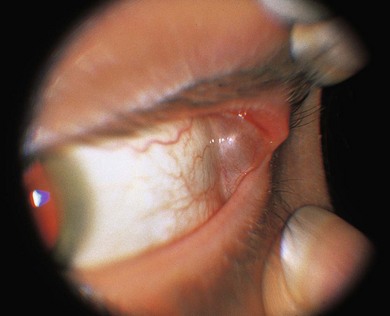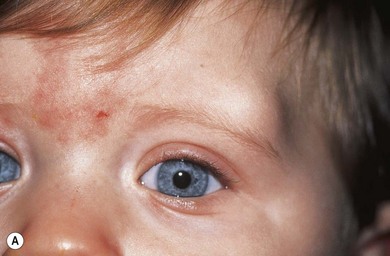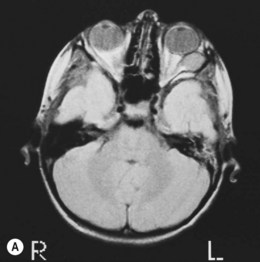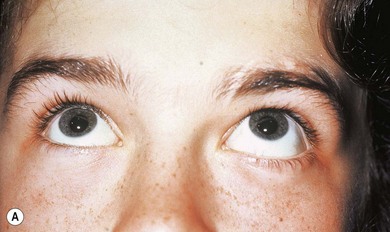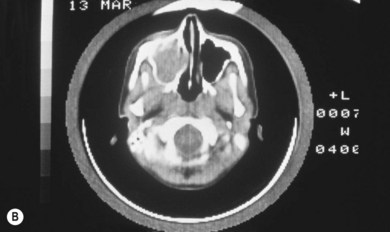Chapter 29 Cystic lesions and ectopias
Cystic lesions
Cystic lesions of the orbit in childhood include dermoid cysts, microphthalmos with cyst, lacrimal ductal cyst, congenital cystic eyeball, encephalocele, sinus mucocele, and teratoma. In some parts of the world parasitic cysts involving organisms such as Echinococcus and Schistosoma are common; these are rare in Europe and North America.1 Hemorrhage within orbital venous lymphatic malformations (lymphangiomas) may give rise to “chocolate” cysts. Cystic lesions of the orbital bones may be seen in fibrous dysplasia, ossifying fibroma, and aneurysmal bone cyst. Cystic orbital lesions were reviewed by Lessner et al.2
Lacrimal ductal cyst
Lacrimal ductal cysts are rare in childhood but an important part of the differential diagnosis of an orbital mass in the lacrimal gland region. Bullock et al.3 suggested that lacrimal cysts should be classified by their site of origin: palpebral lobe (simple dacryops), orbital lobe, accessory glands, or ectopic lacrimal gland. Clinically, they may be confused with superficial conjunctival dermoid (though these are more commonly medial) or inclusion cysts as well as parasitic cysts.
Lacrimal ductal cysts most commonly arise from the palpebral lobe in adults but they may occur in teenagers, sometimes with a history of trauma or inflammation. A smooth, transilluminating mass slowly enlarges in the lateral aspect of the upper lid (Fig. 29.1) and may be evident on lid eversion as a blueish cyst. Rarely, they enlarge with crying and can be tender or painful, occasionally resolving spontaneously as the cyst decompresses with a gush of tears. If the patient is symptomatic, surgical excision of the intact cyst is curative. Marsupialization of larger cysts may be necessary.
Cysts in the orbital lobe are rare; they usually present in infancy or early childhood as a tense mass in the lacrimal fossa. They are larger than their palpebral counterparts. They may enlarge, sometimes suddenly due to inflammation or hemorrhage causing proptosis with inferonasal displacement of the globe or even globe subluxation.4 Deep extension into the posterior orbit may be seen on computed tomography (CT) scan. Excision of the intact cyst is desirable, with lateral orbitotomy if there is posterior extension. Histologically, ductal cysts of the palpebral lobe are lined by an outer layer of myoepithelium and inner layer of cuboidal cells, unlike congenital orbital lobe cysts whose epithelial lining is cuboidal.
Dermoid cyst
Dermoid cysts of the orbit and periorbital region are common in childhood, accounting for 3–9% of orbital masses.5,6 They are developmental choristomas which arise from ectodermal rests trapped at suture lines or within mesenchyme during orbital development.
Dermoids may be superficial or deep.7 Conjunctival dermoids are variants, occurring posterior to the septum in the orbit. Most childhood dermoids are superficial.
Superficial dermoids
These often present in infancy as a rounded mass, typically at the superotemporal (Fig. 29.2) margin of the orbit.8 One-quarter arise in the medial orbit8,9 (Fig. 29.3); these may be lined by stratified squamous epithelium.9 They are painless, non-tender, firm, non-fluctuant, and often immobile, fixed to the underlying bone. Since they are usually situated outside the orbit, they cause no displacement of the globe. The orbital rim is palpable behind their posterior edge. Unsuspected deep extension into the temporalis fossa, posterior orbit, or even intracranial space occasionally occurs in apparently superficial dermoid cysts. These “dumbbell” dermoids may present with the typical signs of superficial dermoid, but extend into the temporalis fossa in an hour-glass configuration (Fig. 29.4) and may be associated with temporalis swelling in 1.5−34% of such cases.10,11 Very rarely, proptosis with or without visual impairment triggered by mastication (masticatory oscillopsia) can result from pressure on a communicating cyst by temporalis contraction with chewing.12 Presentation with orbital cellulitis related to a discharging sinus tract arising from an orbital dermoid has been reported.13 Simultaneous orbital and temporalis fossa dermoid cysts without communication have been described.14
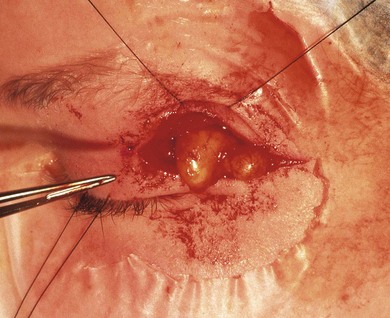
Fig. 29.4 Surgical excision of a “dumbbell” dermoid. The intervening bone has been removed.
(Patient of the University of British Columbia.)
The radiologic appearance of a dermoid cyst is characteristic: on CT scan, the best modality to highlight bony features, a rounded discrete mass is associated with thinning and smooth erosion of the underlying bone. The contents are often of heterogeneous density on CT and magnetic resonance imaging (MRI). Fat lucency was noted in 71% of 70 patients,10 its presence within the cyst is considered diagnostic.15
Excision of superficial dermoid cysts is relatively simple. We prefer to do this by the age of 5 years to avoid accidental rupture or inflammatory episodes related to spontaneous leakage.16 The incision may be situated directly over the lesion above, below, or through the eyebrow. A skin-crease approach11,17 or endoscopic removal18 leaves a less conspicuous postoperative scar. Although excision of the intact cyst is desirable, intraoperative rupture is not disastrous if the contents and the entire cyst wall are carefully removed. Decompression of the cyst may be helpful to expose the underlying bone. Failure to excise the cyst wall completely, or residual cyst contents, can elicit a chronic inflammatory reaction with sinus formation and persistent discharge. Cyst rupture with dramatic inflammatory signs were present in only four of 17 patients with ruptured cysts:19 a low-grade lipogranulomatous response was more common.
A neurosurgical approach with craniectomy may be necessary for safe and complete excision of a dumbbell dermoid extending intracranially.20
Deep dermoids
These present in adolescence and adulthood with gradual enlargement and displacement of orbital contents; they can present similarly in infancy.21 Typically, only their smooth and rounded anterior margin can be palpated although they may extend to the orbital apex.22 The lesion may not be palpable at all (Fig. 29.5).23 Proptosis and/or globe displacement are predominant features but ocular motility,8,24 visual disturbances, and pain may occur. Dermoid cysts may be within24,25 or attached to the lateral rectus muscle.26
The management of deep dermoids can be difficult22,27,28 since total surgical excision is necessary to prevent complications. Preoperative clinical and radiologic assessment is essential to plan the appropriate surgical approach, which may involve combined anterior and lateral orbitotomies or focal marginotomies.22 Although it was felt that this surgery was best delayed until bone growth had ceased,28 such delay may not be necessary to safeguard facial bony growth.
Conjunctival dermoids
One-half of these arise in the medial orbit in relation to the caruncle, usually in teenagers and adults.22 They are not attached to the orbital bones, and are lined by typical conjunctival epithelium with goblet cells and adnexal structures with mucinous or mixed content in the cyst. They are managed by complete excision.
Orbital encephalocele (see Chapter 56)
These rare abnormalities may be congenital or acquired. Congenital lesions arise from a presumed defective separation of neuroectoderm from surface ectoderm, resulting in a bony dehiscence with a “cystic” herniation of dura into the orbit, either alone (meningocele) or with brain tissue (meningo-encephalocele). They may be associated with an optic disc anomaly;29 basal encephalocele should always be excluded in a child with a morning glory disc, especially if there is a midline facial anomaly such as hypertelorism, notched or cleft lip or palate30 (see Chapter 51). Significant cerebral vascular anomalies may be evident.31 Orbital encephaloceles may be acquired as a result of head injury and orbital fracture, with herniation of the dura with or without brain through the bony defect.32,33 Congenital orbital encephaloceles may be anterior or posterior.34 Anterior lesions herniate through single or multiple defects35 in the region of the sutures dividing the frontal, ethmoid, lacrimal, and maxillary bones. They usually present as a congenital cystic swelling of the medial orbit extending onto the face, accompanied by telecanthus and, frequently, epiphora. They may present in infancy and early childhood with gradually increasing forward and lateral globe displacement. The medial canthal tendon is usually displaced in an inferolateral direction. Atypical presentations occur, such as the 10 mm blueish cystic mass in the superonasal fornix of a 1-month-old patient which was found to be a meningoencephalocele.36
Classically, the cyst increases in size on straining or crying.4,37 It may be fluctuant, pulsatile, reducible with gentle pressure, and it may transilluminate. Anterior encephaloceles are important in the differential diagnosis of any medial canthal swelling, having been mistaken for sinus mucoceles, dermoid cysts, or nasolacrimal duct mucoceles.38 A bony defect with intracranial communication is evident on CT scan. Three-dimensional CT reconstruction may be helpful in planning surgery,39 which is usually performed by neurosurgical and/or maxillofacial teams. Posterior encephaloceles herniate into the orbit via the optic foramen, orbital fissures, or a bony defect. They present with slowly progressive, sometimes pulsatile, proptosis. Occasionally, posterior encephaloceles present later.
Typically, the eye is displaced forwards and downwards4 and the proptosis increases on straining or crying. Plain X-rays demonstrate enlarged foramina or a bony defect of the posterior orbit. CT scan demonstrates the size and contents of the cyst. Posterior encephaloceles are particularly associated with the sphenoid wing dysplasia of neurofibromatosis type 1 (NF1); they can also be associated with enophthalmos.
Sinus mucocele
The paranasal sinuses are of clinical relevance to childhood orbital disease and it is important to be familiar with their development. All the sinuses are present at birth in a rudimentary form, except the frontal sinus which first appears at the age of 2 years. There are two spurts of enlargement: at the age of 6 or 7 years, coinciding with the eruption of the second dentition, and again at puberty.40 Since the frontal sinus is the source of most mucoceles, this disorder is rare in childhood. Ethmoidal sinus mucoceles, however, may present in early life,41 particularly with cystic fibrosis.
A mucocele is a cystic expansion of a paranasal sinus, resulting from obstruction of its ostium. The normal mucous secretions of the respiratory epithelial lining accumulate within the sinus, leading to a gradual expansion with loss of its bony structure. With further expansion, the cystic mass transgresses the orbital wall and displaces the orbital contents. It may also erode into the intracranial space.42 Eventually, the cyst contents consist of viscous material which may be white, yellow, or brown and enclosed by a fibrous capsule.
Most mucoceles arise anteriorly, affecting frontal or anterior ethmoid sinuses. The usual presentation is with gradually increasing proptosis (Fig. 29.6) with inferolateral or lateral displacement of the globe, appearing clinically as hypertelorism. A firm cystic non-compressible, non-inflammatory swelling may be palpable in the medial orbit. Its extension above the medial canthal tendon should differentiate it from a mucocele of the lacrimal sac. The absence of pulsatility, expansion with straining, and bony skull defect differentiate it from an encephalocele. Sphenoid sinus mucoceles are rare in childhood but sudden blindness from optic nerve compression by a sphenoid sinus mucocele has been reported.43
Since incomplete excision of the cyst wall is frequently followed by recurrence, the cyst walls should be completely removed or the cyst marsuplialized to the nasal cavity to prevent recurrence and to re-establish sinus drainage. Excision or drainage of the mucocele is usually performed endoscopically by an ENT surgeon.44 The transcaruncular approach has been recommended for the management of fronto-ethmoidal mucoceles.45 After medial incisions are used, careful repositioning of the trochlea is advised to avoid postoperative superior oblique underaction.46 Other cystic lesions arising in the sinuses, including dentigerous cysts, may also cause proptosis.
Stay updated, free articles. Join our Telegram channel

Full access? Get Clinical Tree


